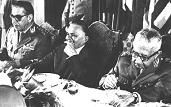Cicloneprojekt,
Estos datos pueden ser interesantes, son antecedentes de los Oyeron de Brasil y Chile (únicos usuarios de LA) de
Jane´s Major Warships….
BRASIL:
General Specifications
Operator: Brazil
Type: Oberon
Class: HUMAITA
Bought: 3
In service: 3
Displacement:
surfaced: 2,030 t
submerged: 2,410 t
Dimensions
Length: 90 (295.2 ft)
Beam: 8.1 m (26.5 ft)
Draught: 5.5 m (18 ft)
Speed:
surfaced: 12 kts
snorting: 10 kts
submerged: 17 kts
Range, surfaced: 9,000 n miles
Complement: 70 (6 officers)
RADAR
Specifications
Type 1006 navigation radar
Role: Navigation
Frequency: I-band
Beam: 1.0 × 18º
Peak power: 25 kW
Antenna gain: 30 dB
Pulsewidth: 0.08/0.25/0.75 μs
Pulse repetition frequency: 725-1,000/
1,450-2,000 pps
Scan rate: 26 rpm
El sonar alcanzó a ser modernizado con el CSU-90, lo mismo que en los 2 Oberon chilenos:
SONARS
Atlas CSU-90-61
CSU-90-61 comprises three main sonars: a low-frequency flank array for long-range detection; an intercept passive sonar; and an attack panoramic passive sonar. The latter has a 2.8 m (9.19 ft) cylindrical hydrophone array and full azimuth coverage and a Demon processing capability. A target detected by any one of the three sonars initiates an automatic process of data collection. CSU 90 is equipped to handle eight independent compound tracks, each providing the warfare system with a complete set of tactical data. The total set of compound tracks comprises: (a) eight
automatic target tracking (ATT) channels for the attack sonar; (b) eight ATT channels for the Demon path, each with eight ALTs (automatic line trackers); and (c) the Target Motion Analyser (TMA), which controls eight compound tracks and generates a sonar tactical display. Optional extensions include a passive ranging sonar, an own noise analyser, acoustic passive classification, automatic warning channel, target motion analyser, a disk memory unit, plotting devices and simulation facilities. The disk memory unit allows all displays and sonar data to be recorded for subsequent analysis and for training. It also handles the data for comparison purposes of the sonar information processor and the classification file for the intercept sonar.
Graseby Marine Type 2007
Type 2007 is a low-frequency system which entered service in 1971; it uses steerable beams to detect and track hostile submarines. The search beams listen at frequencies between 1 and approximately 3 kHz to detect sounds caused by propeller cavitation, nuclear cooling pumps or turbine reduction gears. The array consists of 24 hydrophones
evenly spaced along both sides of the hull.
PROPULSION
Specifications
System: Diesel-electric
Main machinery: 2 Admiralty Standard Range (ASR) 16 VVS-ASR1 diesels; 2.74 MW (3,680 hp)
Electric motors: 2 AEI motors; 4.48 MW (6,000 hp)
Shafts: 2
Battery: 2 groups, each of 224 cells; 5,000 Ah at 1 h rate, 7,420 Ah at 5 h rate
FURTHER INFORMATIONPROGRAMME
The first two boats were ordered from Vickers in 1969 and the third in 1972. There was a serious fire aboard Toneleros which started in the cabling while it was being fitted out, which resulted in it being towed to the Naval Dockyard at Chatham, where the entire centre section was replaced and the boat was completely rewired. As a result of this fire all Oberons under construction were rewired, with consequent delays, but there has been no recurrence of the problem.
MODERNISATION
There were plans in the mid-1980s for a major modernisation programme, which would have included fitting the British Ferranti COMKAFS (Outfit DCH) fire-control system. This programme was, however, cancelled in 1990.
OPERATIONAL
Alone among the users of the `Oberon' class, the Brazilian Navy retains the use of the two short torpedo tubes aft.
THE FUTURE
These three submarines are at the end of their useful lives and at one stage it was proposed to replace them with a class of Brazilian-designed and -built nuclear-powered attack submarines. Difficulties and delays have caused this programme to be postponed and it is now intended to replace them with a design known as the `Improved Tupi', which will be designed and constructed in Brazil, but with diesel-electric power.
CHILE:Los antecedente son mas o menos los mismos, con las siguientes peculariedades:
WEAPONS CONTROL
SISDEF Torpedo Guidance System (TGS) These two submarines were fitted in 1992 with an STN Atlas fire-control system modified by the Chilean naval hardware/software house, SISDEF, in conjunction with STN Atlas. Designated the Torpedo Guidance System (TGS) it is designed to acquire, process, analyse and display data from all sensors fitted in the boat and, in particular for the CSU-90 sonar suite. The system integrates the acoustic arrays, as well as `own noise' hydrophones and accelerometers,
Doppler and EM log; underwater telephone; radar; ESM; optic and optronic sensors and navigation sensors. It can handle all types of torpedo in service with the Chilean Navy.
FURTHER INFORMATIONPROGRAMME
These two submarines were ordered from Scott's Shipbuilding & Engineering Co Ltd, Greenock, in late 1969. Both suffered delays in fitting out due to re-cabling as a result of the fire in the Brazilian Tonelero, followed by a minor explosion in Hyatt in January 1976.
MODERNISATION
The STN Atlas fire-control system was fitted in 1992 and the same company's CSU 90 sonar suite is currently being installed to replace the Type 187.
OPERATIONAL
These two boats collided with each other while running on the surface in April 1987; the damage was limited and was repaired at the Asmar yard at Talcahuano, Chile. The after tubes are no longer used.
Se estima que los sonares CSU-90 fueron reciclados a los U-209…
Saludos cordiales,
![[091]](./images/smilies/091.gif)
![[086]](./images/smilies/086.gif)
).









